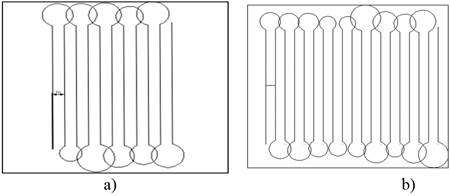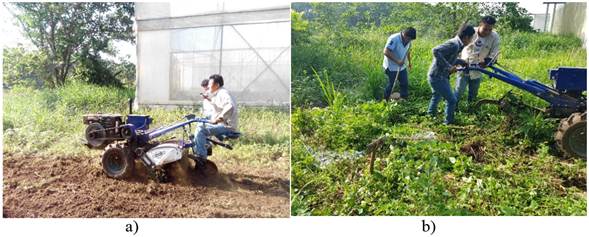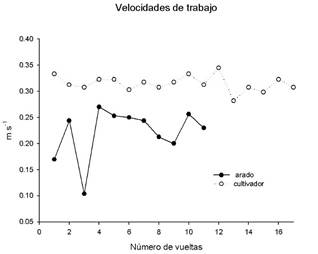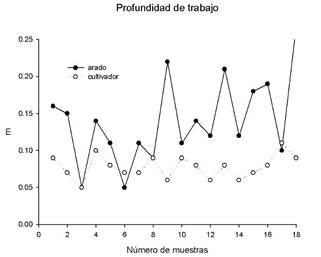INTRODUCTION
The farm tractor is an important tool for agricultural activities because it reduces time, physical labor, increases the amount of surface worked, allows a wide range of implements for different activities to increment agricultural production
Similarly, reducing production costs allows overcoming the seasonal shortage of labor and releasing work in critical periods for other productive activities (Palacios y Ocampo, 2012).
The Valencia Institute of Exportation (2006) cited by Negrete et al. (2012) and Negrete et al. (2013), indicates that in Mexico 34% of the population is engaged in agricultural tasks with very small land areas, 85% of farmers have no more than 5 ha of arable land, including 90% does not reach 3 ha. That indicates the need to use light machinery, one option is the purchase of motor cultivator by its low cost of acquisition
Traditionally in the preparation of soils disc plows, disc harrows, subsoilers, scarifiers and others are used, which are extremely large equipment to be used within greenhouses (Olaguibel y Rubet, 2010). These implements usually have working widths above 1.5 m that characterize the distance between plants in the greenhouses of the region.
The motor cultivator is a source of power for agricultural work for small producers, since it allows performing activities similar to a tractor without the need of experience in the operation, besides optimizing the available spaces in protected agriculture, or in small areas in open field. The length of the area is one of the most important aspects. Due to that it is necessary to minimize the turning areas in the headboards to take advantage of the available space, since it cannot be turned outside the field because its sides are covered with the fabrics that protect cultures from contamination with pests and diseases (Ríos y Villarino, 2014).
In Mexico, even though there are support programs for the acquisition of machinery sponsored by the Federal Government SAGARPA (2017), information on the operation aspects of motor cultivators is not available.
Ayala et al. (2013) mentions that the user of agricultural machinery seeks safety in the operation and quality of tractors. For this reason, there is a need to carry out the relevant tests to evaluate the quality of work of an agricultural machinery.
Having the information obtained from the tests, would allow small producers in the region to make decisions in the acquisition of this equipment that has gained momentum in recent years.
The objective of the present work is to evaluate the operation characteristics of a motor cultivator with two implements (double furrow plow and cultivator). To carry out the evaluation, the Mexican norm NMX-O-182-SCFI (2003) was taken as a guide.
METHODS
The study was carried out in the municipality of Loma Bonita, Oaxaca at coordinates 18º 05 '52,8' 'LN and 95º 53' 46,8 '' LO, at 25 meters above sea level and an average annual temperature of 25ºC. The climate corresponds to a warm humid (Am), according to García (2004). An open field of 200 m2 (10 x 20 m) of surface area was used, located in the facilities of Universidad del Papaloapan campus Loma Bonita with less than 5% slope, 14.2% of maximum humidity. A motor cultivator of the brand KOREI was used. It had a diesel engine of 18 HP 4-stroke with water cooling and electric start, a gearbox of 6 speeds back and forth to work with or without implement and 2 reverse speeds (Table 1) (World Korei Corporation, 2017).
A double-furrow plow was used whose technical characteristics are shown in Table 2. It had a blade cultivator, a wooden box of 1 x 1 m was used for the sampling of weeds, digital scale, plastic bag, stopwatch, 10 m flexometer, 250 ml graduated cylinder, lime, convention industrial oven Binder® brand to obtain soil moisture percentage and a stroboscope brand TENMA® model 72-7601 to measure the angular speed of the engine flywheel.
The tests were carried out with the agricultural set using the "round-trip" movement method and the "open-loop" turnaround method, proposed by the Mexican Standard (Figure 1).

FIGURE 1 a) Behavior of the double furrow- plow turning radius b) Behavior of the cultivator turning radius
The methodology used as a guide for the evaluation of the agricultural set was the Mexican standard NMX-O-182-SCFI (2003). The motor cultivator was placed in the working position and the fuel tank was filled to its maximum capacity. The tests were carried out at an angular speed of the engine of 2 382 rpm in first gear on the plow and on the cultivator. The time, as well as the radius of each round were measured and five soil samples and five weed samples were taken, based on the standard (Figure 2).
TABLE 1 Technical characteristics os the Korei Walking Tractor (World Korei Corporation, 2017)
| # | Korei ® | |
|---|---|---|
| 1 | Power | 18 hp/2,000 min-1 |
| 2 | Fuel | Diesel |
| 3 | Distance between wheels | 92 cm |
| 4 | Start | Electrical |
| 5 | Motor | 1.194 L |
| 6 | Dimensions | 80 x 137 x 290 cm |
| 8 | Weight (kg) | 375 |
| 10 | Traction | 2400 N |
| 11 | Operation velocity | 2-5 km/h |
TABLE 2 Physical characteristics of the implements
| Furrower | Cultivator 18 blades | |
|---|---|---|
| Weight (kg) | 60 | 105 |
| Power | 12-18 hp | 12-18 hp |
| Width | 20 cm | 1m |
| Depth | 12-18 cm | 11cm |
RESULTS AND DISCUSSION
The turning radii were measured, obtaining an average of 0.79 m in the double plow and 0.69 m in the cultivator, averages below the 0.90 m mentioned in the technical data sheet of the motor cultivator.
These values are adequate, especially when working in small areas, it is lower than that obtained by Ríos & Villarino (2014), for a multi- plow Carraro tractor, whose turning radius was 2.04 m.
In relation to the incorporation of weeds, incorporations of 60.9% in the double furrow plow and 78.3% in the cultivator were obtained, values higher than 50% the Mexican norm accepts.
In relation to the soil moisture percentage, results of 10.9% were obtained for the double furrow plow and 14.2% for the cultivator. The measurements can be observed in Table 3. The norm establishes a percentage between 5 and 17% to perform the test.
TABLE 3 Weight of soil and weed samples
| Arado/Plow | Cultivador /Cultivator | |||
|---|---|---|---|---|
| Antes/Before | Después/After | Antes/Before | Después/After | |
| Suelo/Soil | 1280 g | 1140 g | 2390 g | 2050 g |
| Maleza/ Weed | 1510 g | 590 g | 345 g | 75 g |
The average speed calculated with the plow was 0.22 m/s. The fuel consumption was 0.385 liters, in a time of 0.35 hours. In the case of the cultivator, the average speed was 0.31 m/s, with a fuel consumption of 0.220 liters, in 0.29 hours (Figure 3). Both consumptions are within the range of specific consumptions established by Ayala et al. (2013), for agricultural machinery of power less than 20 hp (Ayala et al., 2014).
The cost of fuel for the motor cultivator with the double furrow plow was 19.25 L / ha, in the cultivator the fuel consumption was 11 L / ha. Ranjbarian et al. (2017) reported the consumption of a tractor MF 285, average fuel consumption at different forward speeds of 25.05 L / ha for the disc plow, 25.4 L / ha for the mouldboard plow and 11.4 L / ha for the chisel plow on a tractor. Karparvarfard & Rahmanian (2015) reported 28.6 L / ha on a MF-399 tractor at speeds of 3 km / h for a cultivator at 5 cm deep on a clay soil. Although the comparison is of medium power tractors against the motor cultivator, the data reported by the authors serve as a reference to recommend the use of the motor cultivator as a power source, particularly, in small areas or protected crops.
The average depth measured in the double furrow plow was 0.147 m, which is between the values of 0.12-0.18 m established in the technical specifications and below the requirement mentioned by Villarino et al. (2011) of 0.16 m in a reversible plow using a Corsaro model motor cultivator.
In the cultivator, an average depth of 0.07 m was calculated, below the 0.11 m range established by the technical data sheet of the motor cultivator. Figure 4 shows the different depths obtained in both implements
CONCLUSIONS
A motor cultivator of Korei ® brand was evaluated, with two implements, a double furrow plow and a cultivator. Turning radii were calculated obtaining averages of 0.79 m in the double furrow plow and 0.69 m for the cultivator; these values are acceptable if work is done inside a greenhouse. The average fuel consumption is 19.25 L/ha for the double furrow plow and 11 L/ha for the motor cultivator, which when compared to medium power tractors are below those reported by the authors. Working depths of 0.14 m for the double furrow plow and 0.07 m for the cultivator were obtained.
It is recommended to use the motor cultivator on small surfaces or in areas where a conventional tractor cannot have access to perform work, as well as in greenhouses, shade houses and in work of minimum traction requirements.











 texto en
texto en 





